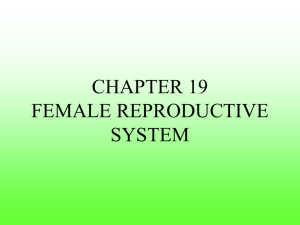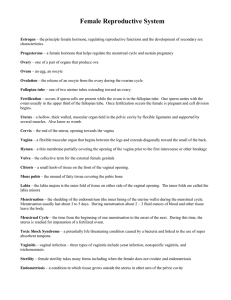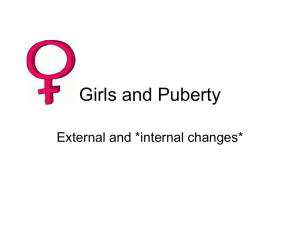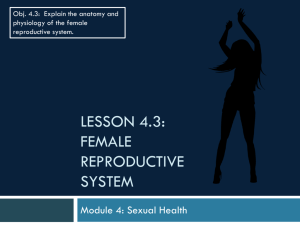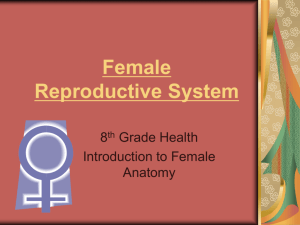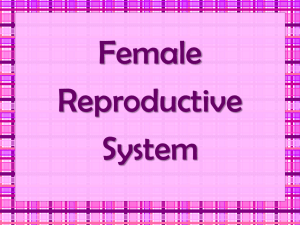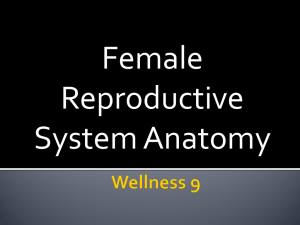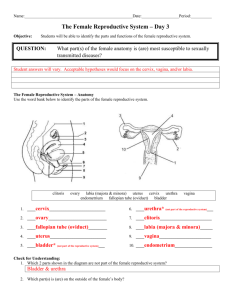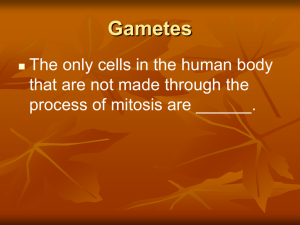Female Reproductive System: Anatomy, Function & Health Concerns
advertisement
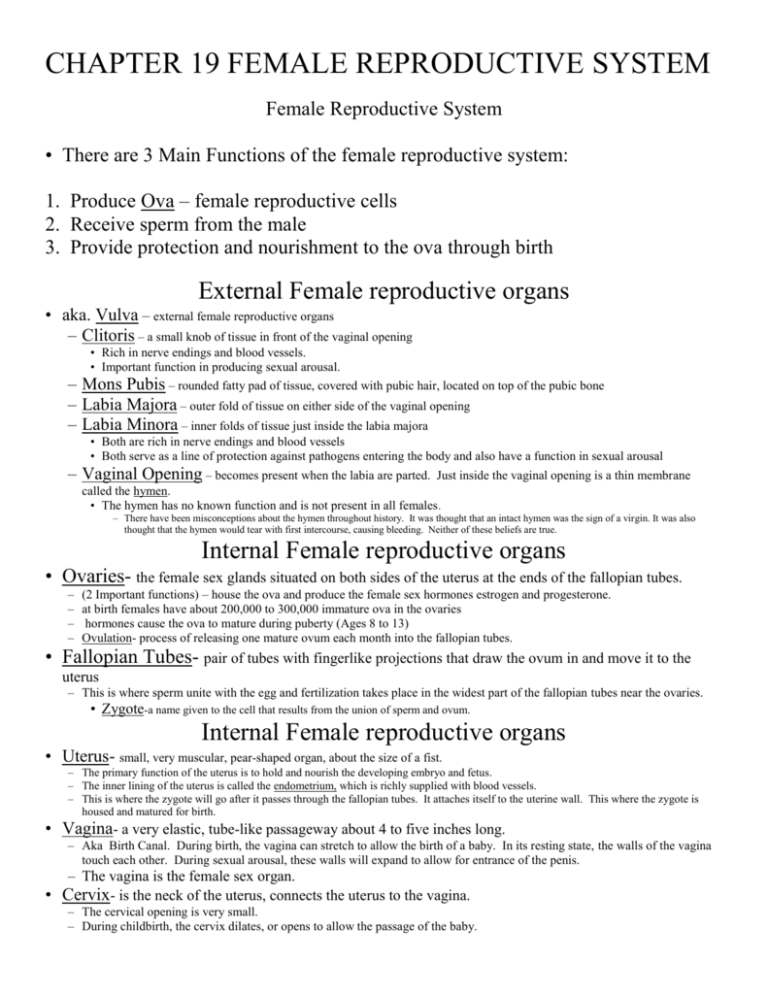
CHAPTER 19 FEMALE REPRODUCTIVE SYSTEM Female Reproductive System • There are 3 Main Functions of the female reproductive system: 1. Produce Ova – female reproductive cells 2. Receive sperm from the male 3. Provide protection and nourishment to the ova through birth External Female reproductive organs • aka. Vulva – external female reproductive organs – Clitoris – a small knob of tissue in front of the vaginal opening • Rich in nerve endings and blood vessels. • Important function in producing sexual arousal. – Mons Pubis – rounded fatty pad of tissue, covered with pubic hair, located on top of the pubic bone – Labia Majora – outer fold of tissue on either side of the vaginal opening – Labia Minora – inner folds of tissue just inside the labia majora • Both are rich in nerve endings and blood vessels • Both serve as a line of protection against pathogens entering the body and also have a function in sexual arousal – Vaginal Opening – becomes present when the labia are parted. Just inside the vaginal opening is a thin membrane called the hymen. • The hymen has no known function and is not present in all females. – There have been misconceptions about the hymen throughout history. It was thought that an intact hymen was the sign of a virgin. It was also thought that the hymen would tear with first intercourse, causing bleeding. Neither of these beliefs are true. Internal Female reproductive organs • Ovaries- the female sex glands situated on both sides of the uterus at the ends of the fallopian tubes. – – – – (2 Important functions) – house the ova and produce the female sex hormones estrogen and progesterone. at birth females have about 200,000 to 300,000 immature ova in the ovaries hormones cause the ova to mature during puberty (Ages 8 to 13) Ovulation- process of releasing one mature ovum each month into the fallopian tubes. • Fallopian Tubes- pair of tubes with fingerlike projections that draw the ovum in and move it to the uterus – This is where sperm unite with the egg and fertilization takes place in the widest part of the fallopian tubes near the ovaries. • Zygote-a name given to the cell that results from the union of sperm and ovum. Internal Female reproductive organs • Uterus- small, very muscular, pear-shaped organ, about the size of a fist. – The primary function of the uterus is to hold and nourish the developing embryo and fetus. – The inner lining of the uterus is called the endometrium, which is richly supplied with blood vessels. – This is where the zygote will go after it passes through the fallopian tubes. It attaches itself to the uterine wall. This where the zygote is housed and matured for birth. • Vagina- a very elastic, tube-like passageway about 4 to five inches long. – Aka Birth Canal. During birth, the vagina can stretch to allow the birth of a baby. In its resting state, the walls of the vagina touch each other. During sexual arousal, these walls will expand to allow for entrance of the penis. – The vagina is the female sex organ. • Cervix- is the neck of the uterus, connects the uterus to the vagina. – The cervical opening is very small. – During childbirth, the cervix dilates, or opens to allow the passage of the baby. Menstruation • Each month, the uterus begins to prepare for the possible pregnancy by building up a rich, thick layer blood and other tissue. If the ovum/egg is not fertilized or if the fertilized ovum/egg does not attach to the uterine walls, the uterine lining is not needed. • Muscles contract causing the uterine wall to break down. • The lining passes through the cervix into the vagina and out the vaginal opening. • The process of shedding the lining of the uterus is called menstruation. – Usually lasts 4 to 7 days, but in some females it may last 3 days and in other 9 or 10 days – This menstrual period is regulated by hormones and will vary from female to female. The abdominal cramps that women get during menstruation are caused by the muscles contracting to break down the lining of the uterus. A female may loose about 2 to 3 tablespoons of blood. The rest of the menstrual flow is the tissue that makes up the lining of the uterus. – Most females begin menstruating between the ages of 10 to 15 – Most women reach menopause, which is the ceasing of mentruration at around age 50 – Hormones control the menstrual cycle. However, nutrition, stress and illness can also have an influence. Concerns with the Female Reproductive System •Premenstrual Syndrome (PMS) – symptoms may appear 2 weeks to a couple of days before period. It is believed to be related to a hormonal imbalance or nutritional deficiencies. •Dysmenorrhea – aka. Menstrual cramps. Light exercise or over the counter pain reliever can help relieve cramps. •Amenorrhea – the lack of menstruation by age 16 or the stopping of a menstrual cycle in a female who has previously menstruated. Can be a result in physical defects of the reproductive organs. More common amenorrhea is caused by excessive athletic activities, emotional distress, eating disorders or starvation. •Toxic Shock Syndrome (TSS) – rare disease caused by a pathogen called Staphylococcus aureus. –Bacteria is commonly found in the skin, mouth and in the vagina. Bacteria can produce a poison that affects the immune system and the liver. The disease can be treated with antibiotics. Most cases of TSS are traced to super absorbent tampons that absorb magnesium and provide an oxygen rich environment in the vagina. •Vaginitis – infection of the vagina. •Sterility – –Blocking of the fallopian tubes. –Female not ovulating. –Endometriosis – Endometrial tissue grows outside the uterus –Untreated STDs •Breast Cancer – most common form of cancer in females and the second leading cause of death in females, next to lung cancer. –2/3 of the cases happen in women over 50 –Lumps under the armpit, in the breast, changes in nipple appearance.\ •Cervical Cancer – a common cancer found in women. A pap smear test is given to determine cervical cancer. Can be treated with removing part of the cervix. •Ovarian Cancer-
